7002ENG Engineering Communication and Leadership: Team Assessment
VerifiedAdded on 2023/06/04
|11
|3301
|131
Report
AI Summary
This report details a team's performance assessment for the 7002ENG Engineering Communication and Leadership course at Griffith University. The team assessed their ease of formation, competencies, leader and follower effectiveness, collaboration quality, planning, productivity, and problem-solving skills. They analyzed Ratan Tata's leadership using models like the Big Five and Path-Goal theory. The team found that democratic leadership fostered participation and trust, and that supportive leadership increased morale. The report highlights the importance of communication, planning, and collaboration in achieving team objectives, concluding that a democratic leadership style enhances team spirit and confidence.
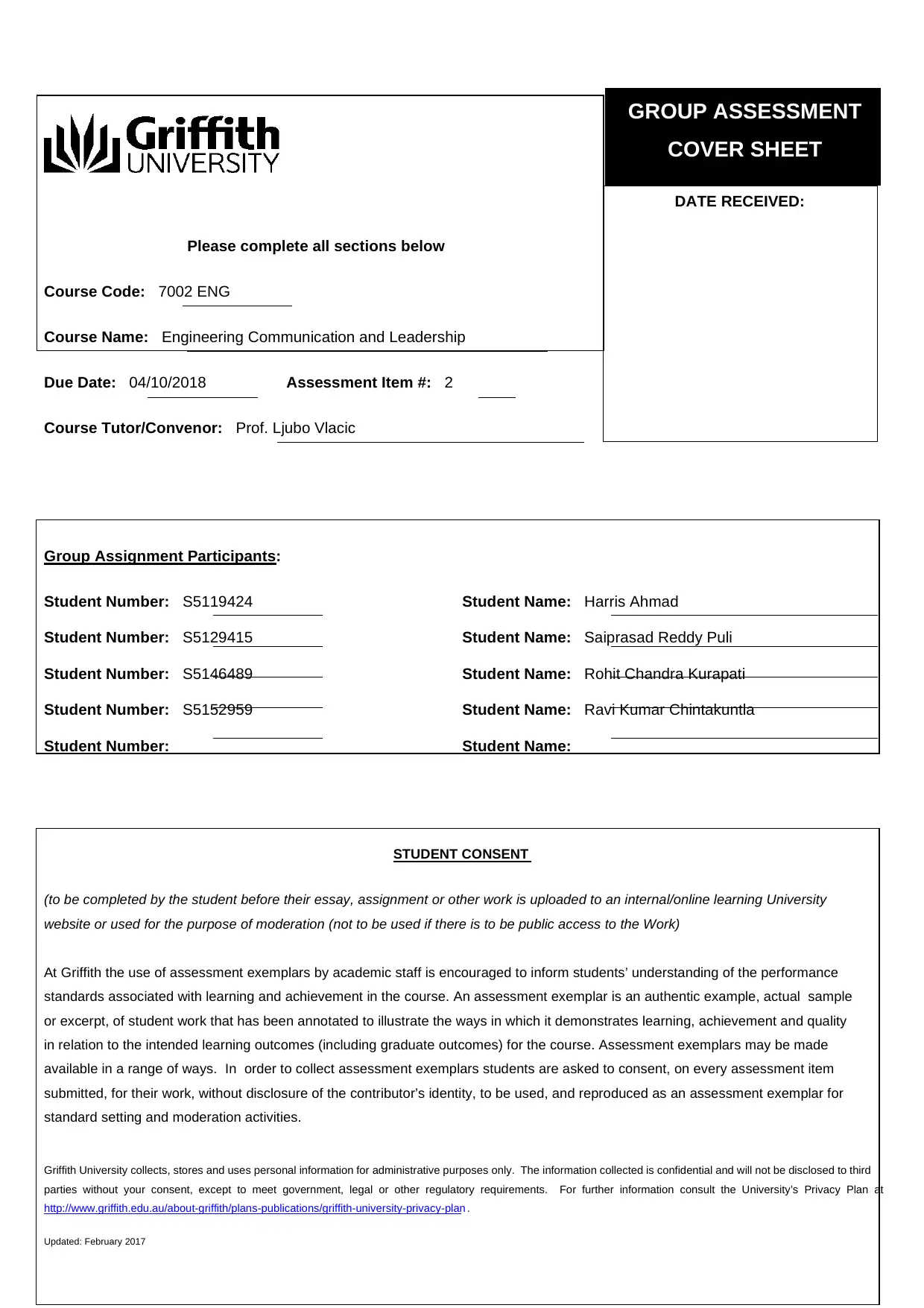
Griffith University collects, stores and uses personal information for administrative purposes only. The information collected is confidential and will not be disclosed to third
parties without your consent, except to meet government, legal or other regulatory requirements. For further information consult the University’s Privacy Plan at
http://www.griffith.edu.au/about-griffith/plans-publications/griffith-university-privacy-plan .
Updated: February 2017
Please complete all sections below
Course Code: 7002 ENG
Course Name: Engineering Communication and Leadership
Due Date: 04/10/2018 Assessment Item #: 2
Course Tutor/Convenor: Prof. Ljubo Vlacic
Group Assignment Participants:
Student Number: S5119424 Student Name: Harris Ahmad
Student Number: S5129415 Student Name: Saiprasad Reddy Puli
Student Number: S5146489 Student Name: Rohit Chandra Kurapati
Student Number: S5152959 Student Name: Ravi Kumar Chintakuntla
Student Number: Student Name:
STUDENT CONSENT
(to be completed by the student before their essay, assignment or other work is uploaded to an internal/online learning University
website or used for the purpose of moderation (not to be used if there is to be public access to the Work)
At Griffith the use of assessment exemplars by academic staff is encouraged to inform students’ understanding of the performance
standards associated with learning and achievement in the course. An assessment exemplar is an authentic example, actual sample
or excerpt, of student work that has been annotated to illustrate the ways in which it demonstrates learning, achievement and quality
in relation to the intended learning outcomes (including graduate outcomes) for the course. Assessment exemplars may be made
available in a range of ways. In order to collect assessment exemplars students are asked to consent, on every assessment item
submitted, for their work, without disclosure of the contributor’s identity, to be used, and reproduced as an assessment exemplar for
standard setting and moderation activities.
GROUP ASSESSMENT
COVER SHEET
DATE RECEIVED:
parties without your consent, except to meet government, legal or other regulatory requirements. For further information consult the University’s Privacy Plan at
http://www.griffith.edu.au/about-griffith/plans-publications/griffith-university-privacy-plan .
Updated: February 2017
Please complete all sections below
Course Code: 7002 ENG
Course Name: Engineering Communication and Leadership
Due Date: 04/10/2018 Assessment Item #: 2
Course Tutor/Convenor: Prof. Ljubo Vlacic
Group Assignment Participants:
Student Number: S5119424 Student Name: Harris Ahmad
Student Number: S5129415 Student Name: Saiprasad Reddy Puli
Student Number: S5146489 Student Name: Rohit Chandra Kurapati
Student Number: S5152959 Student Name: Ravi Kumar Chintakuntla
Student Number: Student Name:
STUDENT CONSENT
(to be completed by the student before their essay, assignment or other work is uploaded to an internal/online learning University
website or used for the purpose of moderation (not to be used if there is to be public access to the Work)
At Griffith the use of assessment exemplars by academic staff is encouraged to inform students’ understanding of the performance
standards associated with learning and achievement in the course. An assessment exemplar is an authentic example, actual sample
or excerpt, of student work that has been annotated to illustrate the ways in which it demonstrates learning, achievement and quality
in relation to the intended learning outcomes (including graduate outcomes) for the course. Assessment exemplars may be made
available in a range of ways. In order to collect assessment exemplars students are asked to consent, on every assessment item
submitted, for their work, without disclosure of the contributor’s identity, to be used, and reproduced as an assessment exemplar for
standard setting and moderation activities.
GROUP ASSESSMENT
COVER SHEET
DATE RECEIVED:
Paraphrase This Document
Need a fresh take? Get an instant paraphrase of this document with our AI Paraphraser
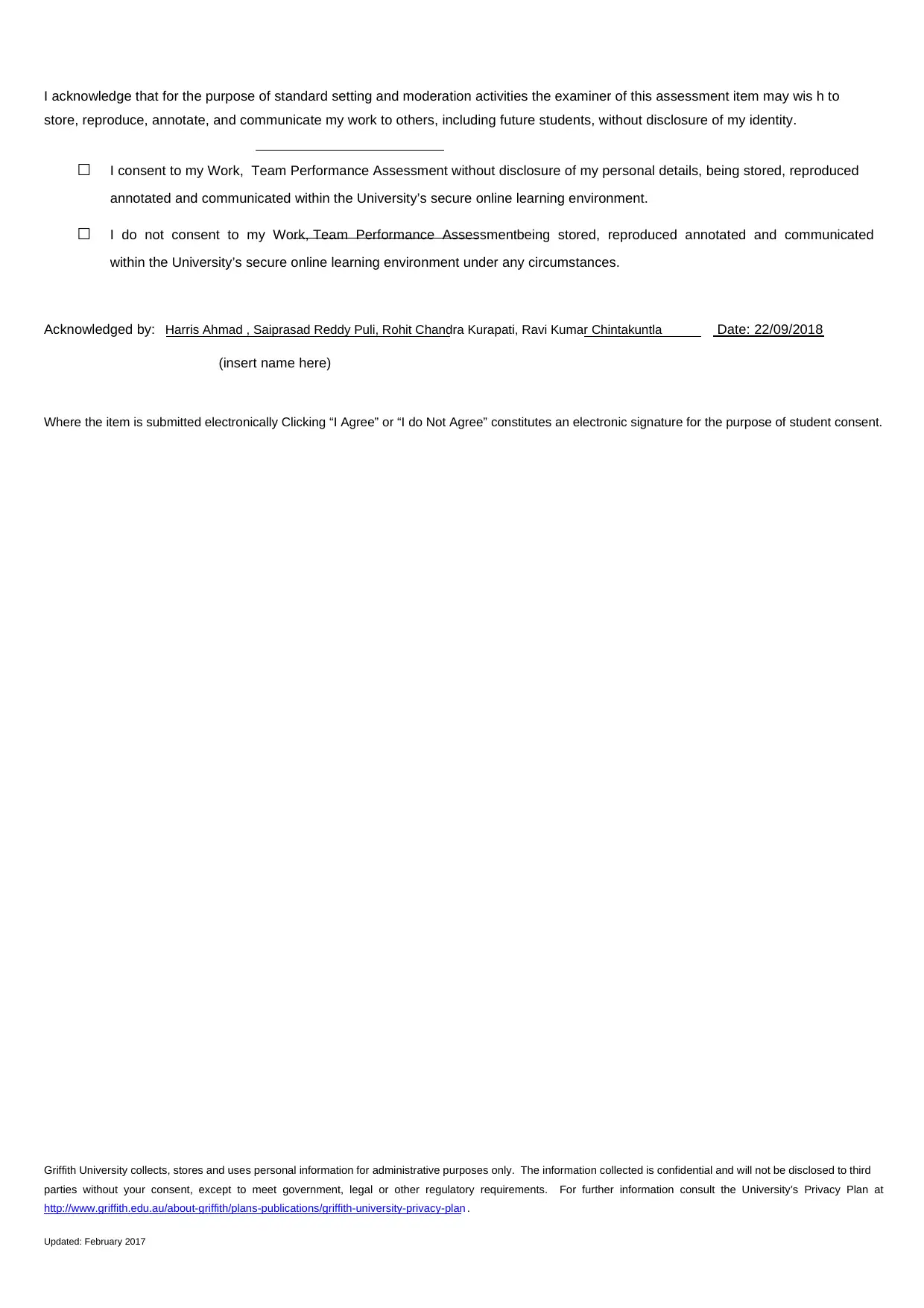
Griffith University collects, stores and uses personal information for administrative purposes only. The information collected is confidential and will not be disclosed to third
parties without your consent, except to meet government, legal or other regulatory requirements. For further information consult the University’s Privacy Plan at
http://www.griffith.edu.au/about-griffith/plans-publications/griffith-university-privacy-plan .
Updated: February 2017
I acknowledge that for the purpose of standard setting and moderation activities the examiner of this assessment item may wis h to
store, reproduce, annotate, and communicate my work to others, including future students, without disclosure of my identity.
☐ I consent to my Work, Team Performance Assessment without disclosure of my personal details, being stored, reproduced
annotated and communicated within the University’s secure online learning environment.
☐ I do not consent to my Work, Team Performance Assessmentbeing stored, reproduced annotated and communicated
within the University’s secure online learning environment under any circumstances.
Acknowledged by: Harris Ahmad , Saiprasad Reddy Puli, Rohit Chandra Kurapati, Ravi Kumar Chintakuntla Date: 22/09/2018
(insert name here)
Where the item is submitted electronically Clicking “I Agree” or “I do Not Agree” constitutes an electronic signature for the purpose of student consent.
parties without your consent, except to meet government, legal or other regulatory requirements. For further information consult the University’s Privacy Plan at
http://www.griffith.edu.au/about-griffith/plans-publications/griffith-university-privacy-plan .
Updated: February 2017
I acknowledge that for the purpose of standard setting and moderation activities the examiner of this assessment item may wis h to
store, reproduce, annotate, and communicate my work to others, including future students, without disclosure of my identity.
☐ I consent to my Work, Team Performance Assessment without disclosure of my personal details, being stored, reproduced
annotated and communicated within the University’s secure online learning environment.
☐ I do not consent to my Work, Team Performance Assessmentbeing stored, reproduced annotated and communicated
within the University’s secure online learning environment under any circumstances.
Acknowledged by: Harris Ahmad , Saiprasad Reddy Puli, Rohit Chandra Kurapati, Ravi Kumar Chintakuntla Date: 22/09/2018
(insert name here)
Where the item is submitted electronically Clicking “I Agree” or “I do Not Agree” constitutes an electronic signature for the purpose of student consent.
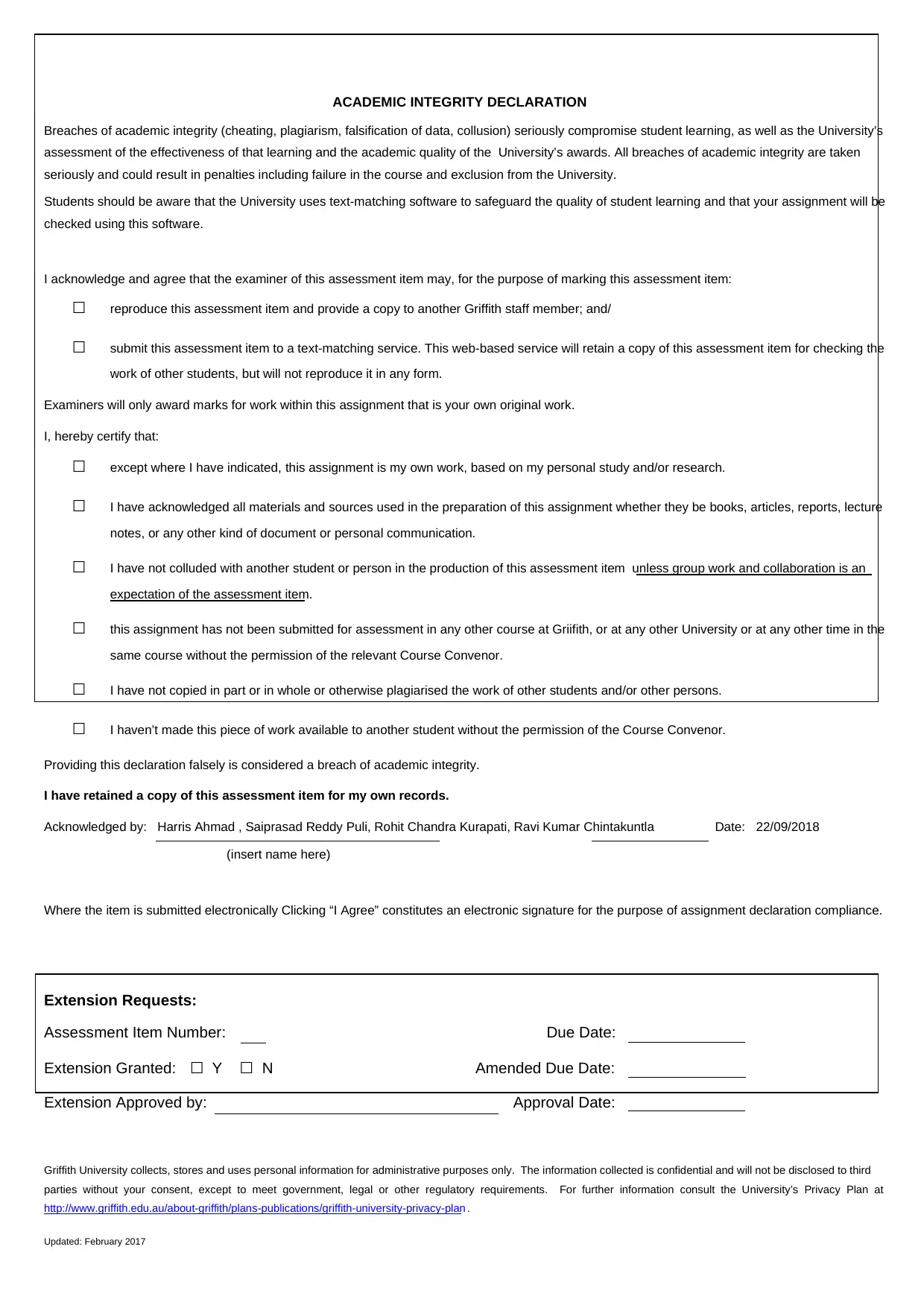
Griffith University collects, stores and uses personal information for administrative purposes only. The information collected is confidential and will not be disclosed to third
parties without your consent, except to meet government, legal or other regulatory requirements. For further information consult the University’s Privacy Plan at
http://www.griffith.edu.au/about-griffith/plans-publications/griffith-university-privacy-plan .
Updated: February 2017
ACADEMIC INTEGRITY DECLARATION
Breaches of academic integrity (cheating, plagiarism, falsification of data, collusion) seriously compromise student learning, as well as the University’s
assessment of the effectiveness of that learning and the academic quality of the University’s awards. All breaches of academic integrity are taken
seriously and could result in penalties including failure in the course and exclusion from the University.
Students should be aware that the University uses text-matching software to safeguard the quality of student learning and that your assignment will be
checked using this software.
I acknowledge and agree that the examiner of this assessment item may, for the purpose of marking this assessment item:
☐ reproduce this assessment item and provide a copy to another Griffith staff member; and/
☐ submit this assessment item to a text-matching service. This web-based service will retain a copy of this assessment item for checking the
work of other students, but will not reproduce it in any form.
Examiners will only award marks for work within this assignment that is your own original work.
I, hereby certify that:
☐ except where I have indicated, this assignment is my own work, based on my personal study and/or research.
☐ I have acknowledged all materials and sources used in the preparation of this assignment whether they be books, articles, reports, lecture
notes, or any other kind of document or personal communication.
☐ I have not colluded with another student or person in the production of this assessment item unless group work and collaboration is an
expectation of the assessment item.
☐ this assignment has not been submitted for assessment in any other course at Griifith, or at any other University or at any other time in the
same course without the permission of the relevant Course Convenor.
☐ I have not copied in part or in whole or otherwise plagiarised the work of other students and/or other persons.
☐ I haven’t made this piece of work available to another student without the permission of the Course Convenor.
Providing this declaration falsely is considered a breach of academic integrity.
I have retained a copy of this assessment item for my own records.
Acknowledged by: Harris Ahmad , Saiprasad Reddy Puli, Rohit Chandra Kurapati, Ravi Kumar Chintakuntla Date: 22/09/2018
(insert name here)
Where the item is submitted electronically Clicking “I Agree” constitutes an electronic signature for the purpose of assignment declaration compliance.
Extension Requests:
Assessment Item Number: Due Date:
Extension Granted: ☐ Y ☐ N Amended Due Date:
Extension Approved by: Approval Date:
parties without your consent, except to meet government, legal or other regulatory requirements. For further information consult the University’s Privacy Plan at
http://www.griffith.edu.au/about-griffith/plans-publications/griffith-university-privacy-plan .
Updated: February 2017
ACADEMIC INTEGRITY DECLARATION
Breaches of academic integrity (cheating, plagiarism, falsification of data, collusion) seriously compromise student learning, as well as the University’s
assessment of the effectiveness of that learning and the academic quality of the University’s awards. All breaches of academic integrity are taken
seriously and could result in penalties including failure in the course and exclusion from the University.
Students should be aware that the University uses text-matching software to safeguard the quality of student learning and that your assignment will be
checked using this software.
I acknowledge and agree that the examiner of this assessment item may, for the purpose of marking this assessment item:
☐ reproduce this assessment item and provide a copy to another Griffith staff member; and/
☐ submit this assessment item to a text-matching service. This web-based service will retain a copy of this assessment item for checking the
work of other students, but will not reproduce it in any form.
Examiners will only award marks for work within this assignment that is your own original work.
I, hereby certify that:
☐ except where I have indicated, this assignment is my own work, based on my personal study and/or research.
☐ I have acknowledged all materials and sources used in the preparation of this assignment whether they be books, articles, reports, lecture
notes, or any other kind of document or personal communication.
☐ I have not colluded with another student or person in the production of this assessment item unless group work and collaboration is an
expectation of the assessment item.
☐ this assignment has not been submitted for assessment in any other course at Griifith, or at any other University or at any other time in the
same course without the permission of the relevant Course Convenor.
☐ I have not copied in part or in whole or otherwise plagiarised the work of other students and/or other persons.
☐ I haven’t made this piece of work available to another student without the permission of the Course Convenor.
Providing this declaration falsely is considered a breach of academic integrity.
I have retained a copy of this assessment item for my own records.
Acknowledged by: Harris Ahmad , Saiprasad Reddy Puli, Rohit Chandra Kurapati, Ravi Kumar Chintakuntla Date: 22/09/2018
(insert name here)
Where the item is submitted electronically Clicking “I Agree” constitutes an electronic signature for the purpose of assignment declaration compliance.
Extension Requests:
Assessment Item Number: Due Date:
Extension Granted: ☐ Y ☐ N Amended Due Date:
Extension Approved by: Approval Date:
⊘ This is a preview!⊘
Do you want full access?
Subscribe today to unlock all pages.

Trusted by 1+ million students worldwide
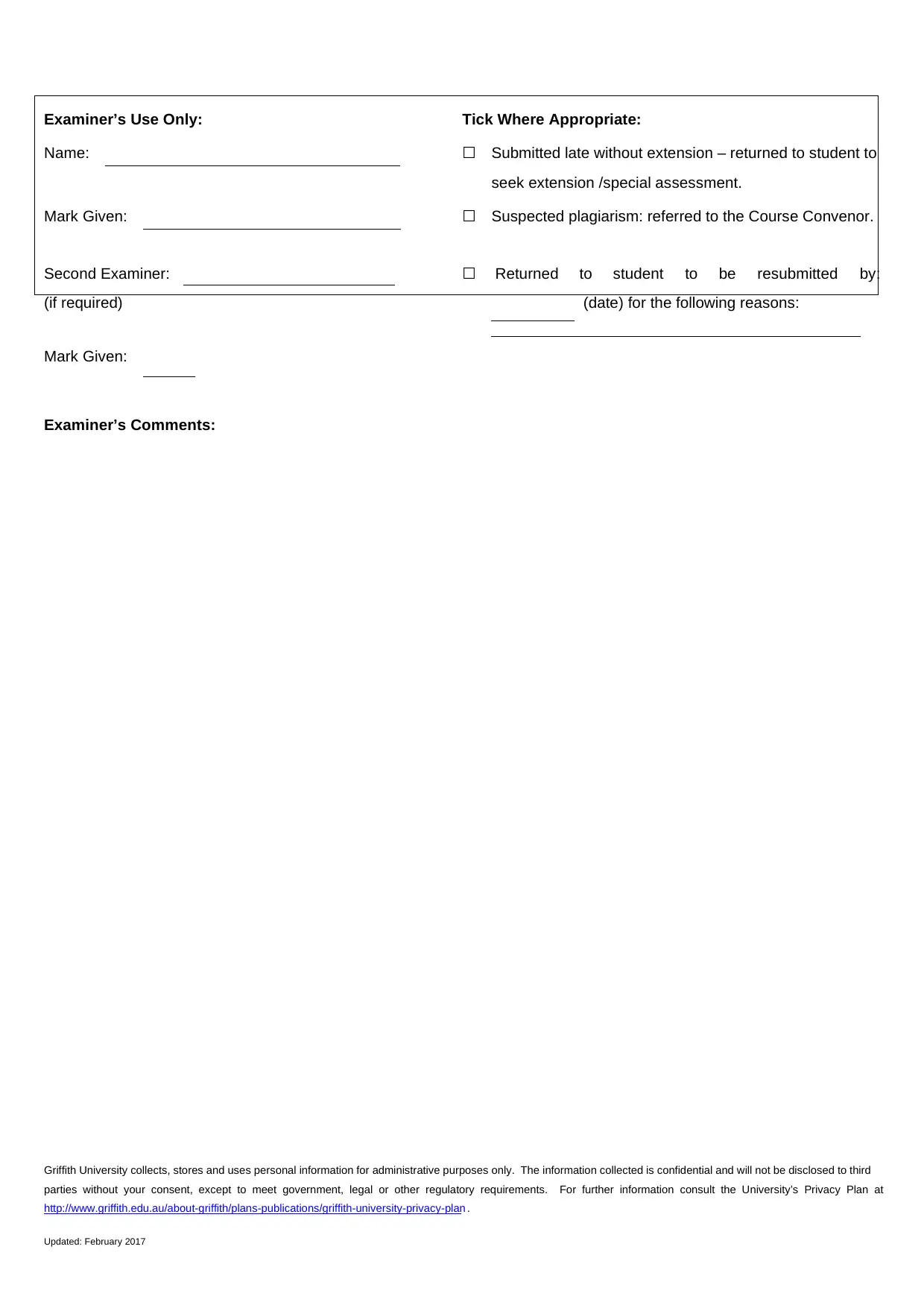
Griffith University collects, stores and uses personal information for administrative purposes only. The information collected is confidential and will not be disclosed to third
parties without your consent, except to meet government, legal or other regulatory requirements. For further information consult the University’s Privacy Plan at
http://www.griffith.edu.au/about-griffith/plans-publications/griffith-university-privacy-plan .
Updated: February 2017
Examiner’s Use Only: Tick Where Appropriate:
Name: ☐ Submitted late without extension – returned to student to
seek extension /special assessment.
Mark Given: ☐ Suspected plagiarism: referred to the Course Convenor.
Second Examiner: ☐ Returned to student to be resubmitted by:
(if required) (date) for the following reasons:
Mark Given:
Examiner’s Comments:
parties without your consent, except to meet government, legal or other regulatory requirements. For further information consult the University’s Privacy Plan at
http://www.griffith.edu.au/about-griffith/plans-publications/griffith-university-privacy-plan .
Updated: February 2017
Examiner’s Use Only: Tick Where Appropriate:
Name: ☐ Submitted late without extension – returned to student to
seek extension /special assessment.
Mark Given: ☐ Suspected plagiarism: referred to the Course Convenor.
Second Examiner: ☐ Returned to student to be resubmitted by:
(if required) (date) for the following reasons:
Mark Given:
Examiner’s Comments:
Paraphrase This Document
Need a fresh take? Get an instant paraphrase of this document with our AI Paraphraser
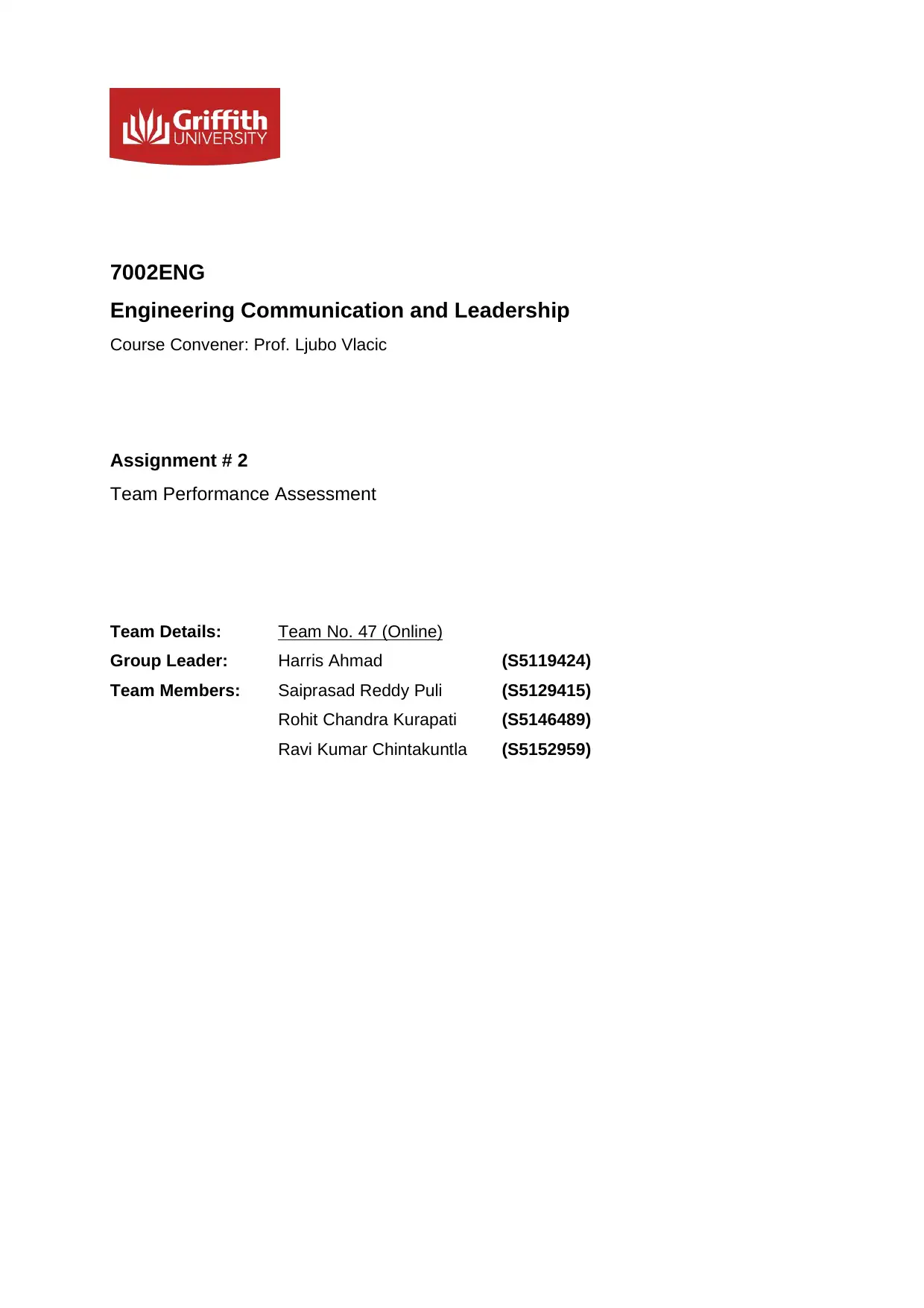
7002ENG
Engineering Communication and Leadership
Course Convener: Prof. Ljubo Vlacic
Assignment # 2
Team Performance Assessment
Team Details: Team No. 47 (Online)
Group Leader: Harris Ahmad (S5119424)
Team Members: Saiprasad Reddy Puli (S5129415)
Rohit Chandra Kurapati (S5146489)
Ravi Kumar Chintakuntla (S5152959)
Engineering Communication and Leadership
Course Convener: Prof. Ljubo Vlacic
Assignment # 2
Team Performance Assessment
Team Details: Team No. 47 (Online)
Group Leader: Harris Ahmad (S5119424)
Team Members: Saiprasad Reddy Puli (S5129415)
Rohit Chandra Kurapati (S5146489)
Ravi Kumar Chintakuntla (S5152959)
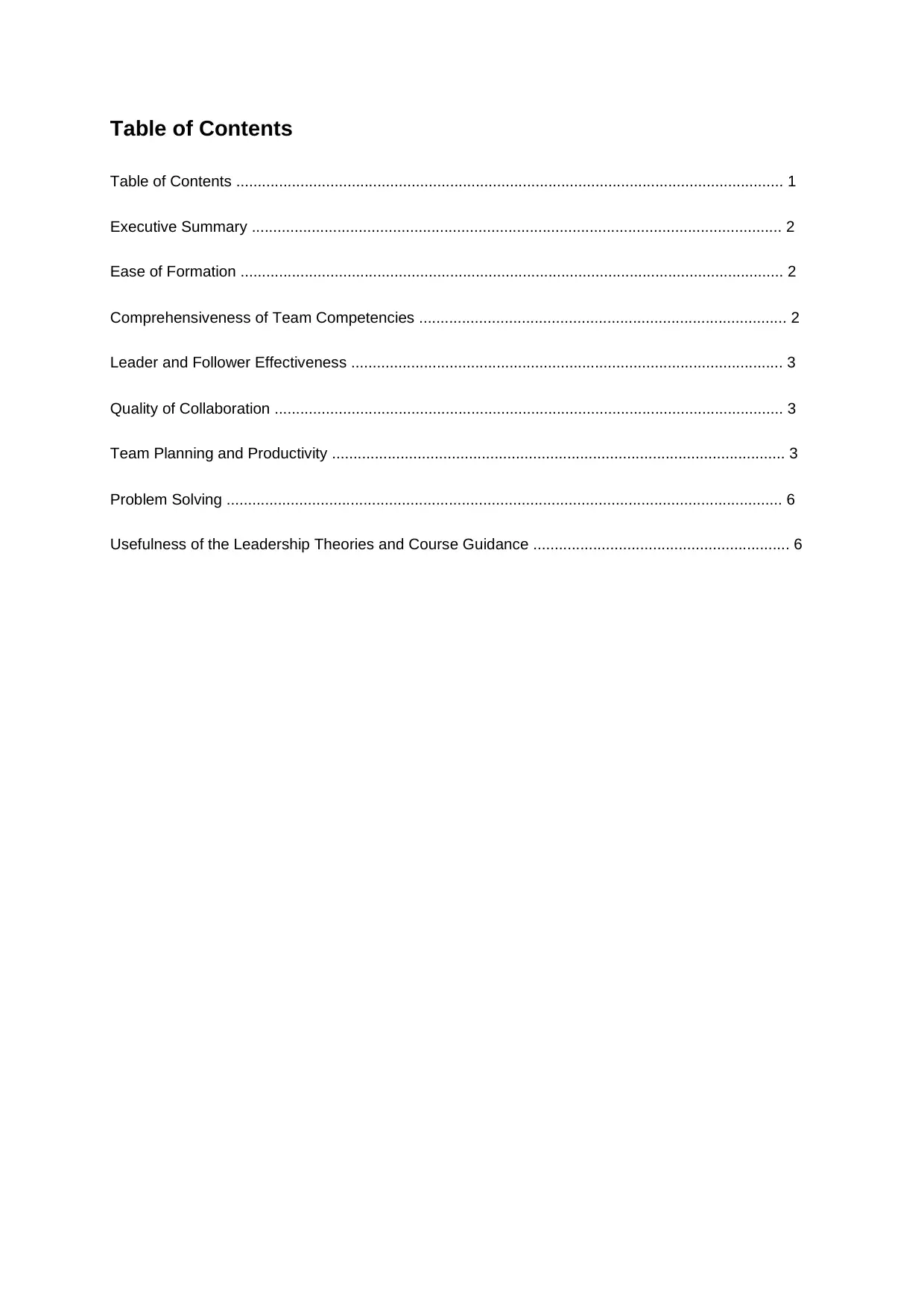
Table of Contents
Table of Contents ................................................................................................................................ 1
Executive Summary ............................................................................................................................ 2
Ease of Formation ............................................................................................................................... 2
Comprehensiveness of Team Competencies ...................................................................................... 2
Leader and Follower Effectiveness ..................................................................................................... 3
Quality of Collaboration ....................................................................................................................... 3
Team Planning and Productivity .......................................................................................................... 3
Problem Solving .................................................................................................................................. 6
Usefulness of the Leadership Theories and Course Guidance ............................................................ 6
Table of Contents ................................................................................................................................ 1
Executive Summary ............................................................................................................................ 2
Ease of Formation ............................................................................................................................... 2
Comprehensiveness of Team Competencies ...................................................................................... 2
Leader and Follower Effectiveness ..................................................................................................... 3
Quality of Collaboration ....................................................................................................................... 3
Team Planning and Productivity .......................................................................................................... 3
Problem Solving .................................................................................................................................. 6
Usefulness of the Leadership Theories and Course Guidance ............................................................ 6
⊘ This is a preview!⊘
Do you want full access?
Subscribe today to unlock all pages.

Trusted by 1+ million students worldwide
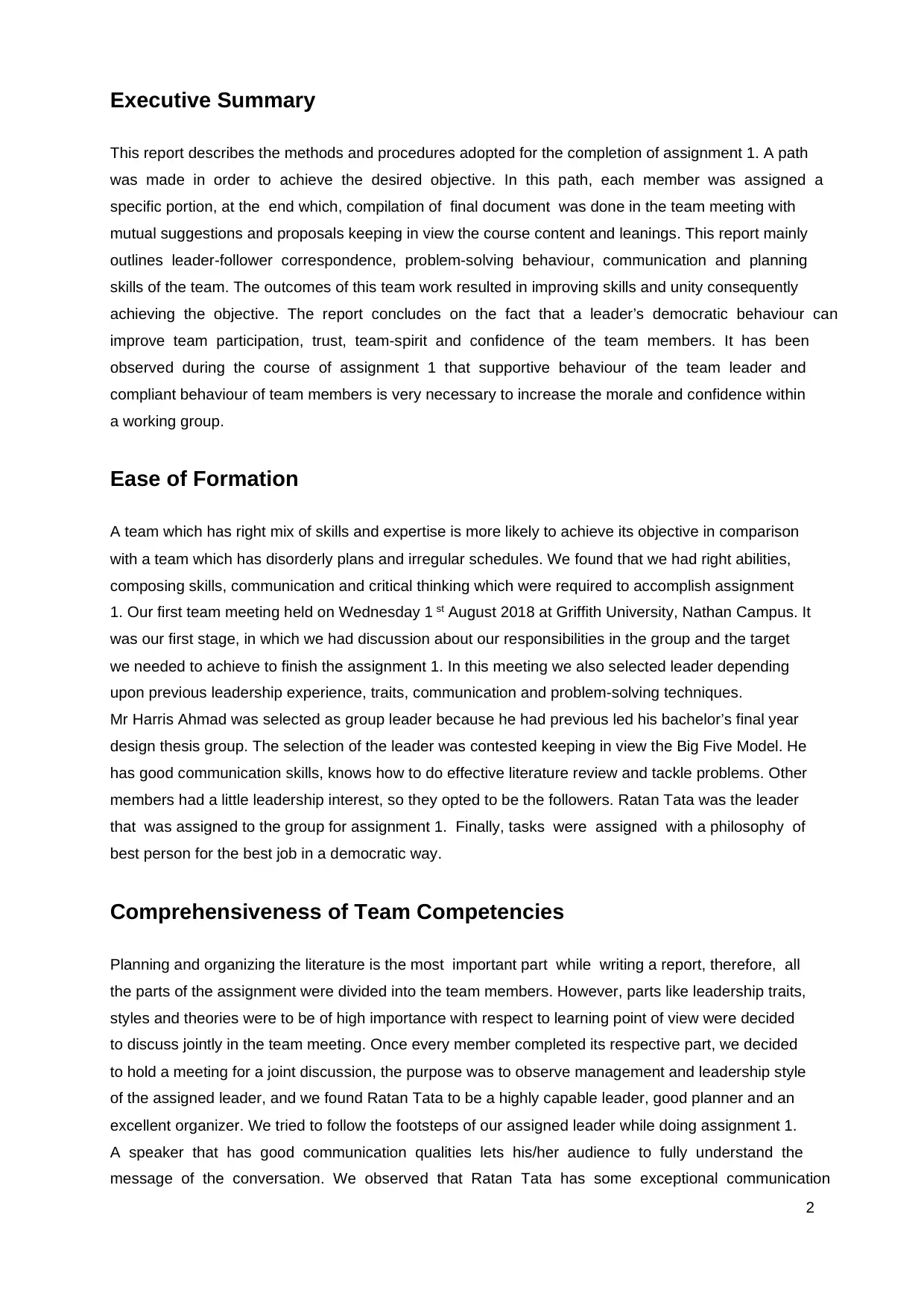
2
Executive Summary
This report describes the methods and procedures adopted for the completion of assignment 1. A path
was made in order to achieve the desired objective. In this path, each member was assigned a
specific portion, at the end which, compilation of final document was done in the team meeting with
mutual suggestions and proposals keeping in view the course content and leanings. This report mainly
outlines leader-follower correspondence, problem-solving behaviour, communication and planning
skills of the team. The outcomes of this team work resulted in improving skills and unity consequently
achieving the objective. The report concludes on the fact that a leader’s democratic behaviour can
improve team participation, trust, team-spirit and confidence of the team members. It has been
observed during the course of assignment 1 that supportive behaviour of the team leader and
compliant behaviour of team members is very necessary to increase the morale and confidence within
a working group.
Ease of Formation
A team which has right mix of skills and expertise is more likely to achieve its objective in comparison
with a team which has disorderly plans and irregular schedules. We found that we had right abilities,
composing skills, communication and critical thinking which were required to accomplish assignment
1. Our first team meeting held on Wednesday 1 st August 2018 at Griffith University, Nathan Campus. It
was our first stage, in which we had discussion about our responsibilities in the group and the target
we needed to achieve to finish the assignment 1. In this meeting we also selected leader depending
upon previous leadership experience, traits, communication and problem-solving techniques.
Mr Harris Ahmad was selected as group leader because he had previous led his bachelor’s final year
design thesis group. The selection of the leader was contested keeping in view the Big Five Model. He
has good communication skills, knows how to do effective literature review and tackle problems. Other
members had a little leadership interest, so they opted to be the followers. Ratan Tata was the leader
that was assigned to the group for assignment 1. Finally, tasks were assigned with a philosophy of
best person for the best job in a democratic way.
Comprehensiveness of Team Competencies
Planning and organizing the literature is the most important part while writing a report, therefore, all
the parts of the assignment were divided into the team members. However, parts like leadership traits,
styles and theories were to be of high importance with respect to learning point of view were decided
to discuss jointly in the team meeting. Once every member completed its respective part, we decided
to hold a meeting for a joint discussion, the purpose was to observe management and leadership style
of the assigned leader, and we found Ratan Tata to be a highly capable leader, good planner and an
excellent organizer. We tried to follow the footsteps of our assigned leader while doing assignment 1.
A speaker that has good communication qualities lets his/her audience to fully understand the
message of the conversation. We observed that Ratan Tata has some exceptional communication
Executive Summary
This report describes the methods and procedures adopted for the completion of assignment 1. A path
was made in order to achieve the desired objective. In this path, each member was assigned a
specific portion, at the end which, compilation of final document was done in the team meeting with
mutual suggestions and proposals keeping in view the course content and leanings. This report mainly
outlines leader-follower correspondence, problem-solving behaviour, communication and planning
skills of the team. The outcomes of this team work resulted in improving skills and unity consequently
achieving the objective. The report concludes on the fact that a leader’s democratic behaviour can
improve team participation, trust, team-spirit and confidence of the team members. It has been
observed during the course of assignment 1 that supportive behaviour of the team leader and
compliant behaviour of team members is very necessary to increase the morale and confidence within
a working group.
Ease of Formation
A team which has right mix of skills and expertise is more likely to achieve its objective in comparison
with a team which has disorderly plans and irregular schedules. We found that we had right abilities,
composing skills, communication and critical thinking which were required to accomplish assignment
1. Our first team meeting held on Wednesday 1 st August 2018 at Griffith University, Nathan Campus. It
was our first stage, in which we had discussion about our responsibilities in the group and the target
we needed to achieve to finish the assignment 1. In this meeting we also selected leader depending
upon previous leadership experience, traits, communication and problem-solving techniques.
Mr Harris Ahmad was selected as group leader because he had previous led his bachelor’s final year
design thesis group. The selection of the leader was contested keeping in view the Big Five Model. He
has good communication skills, knows how to do effective literature review and tackle problems. Other
members had a little leadership interest, so they opted to be the followers. Ratan Tata was the leader
that was assigned to the group for assignment 1. Finally, tasks were assigned with a philosophy of
best person for the best job in a democratic way.
Comprehensiveness of Team Competencies
Planning and organizing the literature is the most important part while writing a report, therefore, all
the parts of the assignment were divided into the team members. However, parts like leadership traits,
styles and theories were to be of high importance with respect to learning point of view were decided
to discuss jointly in the team meeting. Once every member completed its respective part, we decided
to hold a meeting for a joint discussion, the purpose was to observe management and leadership style
of the assigned leader, and we found Ratan Tata to be a highly capable leader, good planner and an
excellent organizer. We tried to follow the footsteps of our assigned leader while doing assignment 1.
A speaker that has good communication qualities lets his/her audience to fully understand the
message of the conversation. We observed that Ratan Tata has some exceptional communication
Paraphrase This Document
Need a fresh take? Get an instant paraphrase of this document with our AI Paraphraser
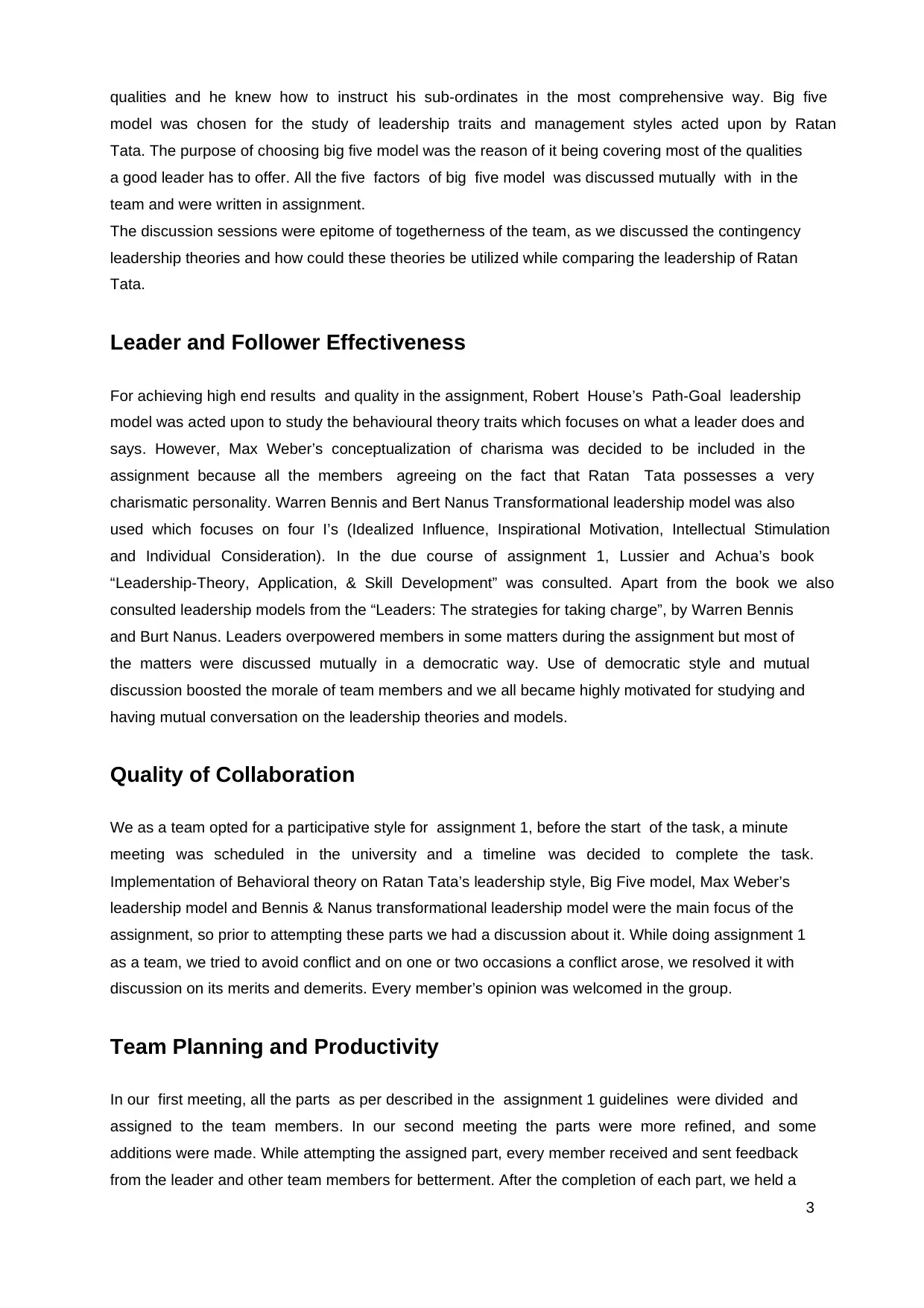
3
qualities and he knew how to instruct his sub-ordinates in the most comprehensive way. Big five
model was chosen for the study of leadership traits and management styles acted upon by Ratan
Tata. The purpose of choosing big five model was the reason of it being covering most of the qualities
a good leader has to offer. All the five factors of big five model was discussed mutually with in the
team and were written in assignment.
The discussion sessions were epitome of togetherness of the team, as we discussed the contingency
leadership theories and how could these theories be utilized while comparing the leadership of Ratan
Tata.
Leader and Follower Effectiveness
For achieving high end results and quality in the assignment, Robert House’s Path-Goal leadership
model was acted upon to study the behavioural theory traits which focuses on what a leader does and
says. However, Max Weber’s conceptualization of charisma was decided to be included in the
assignment because all the members agreeing on the fact that Ratan Tata possesses a very
charismatic personality. Warren Bennis and Bert Nanus Transformational leadership model was also
used which focuses on four I’s (Idealized Influence, Inspirational Motivation, Intellectual Stimulation
and Individual Consideration). In the due course of assignment 1, Lussier and Achua’s book
“Leadership-Theory, Application, & Skill Development” was consulted. Apart from the book we also
consulted leadership models from the “Leaders: The strategies for taking charge”, by Warren Bennis
and Burt Nanus. Leaders overpowered members in some matters during the assignment but most of
the matters were discussed mutually in a democratic way. Use of democratic style and mutual
discussion boosted the morale of team members and we all became highly motivated for studying and
having mutual conversation on the leadership theories and models.
Quality of Collaboration
We as a team opted for a participative style for assignment 1, before the start of the task, a minute
meeting was scheduled in the university and a timeline was decided to complete the task.
Implementation of Behavioral theory on Ratan Tata’s leadership style, Big Five model, Max Weber’s
leadership model and Bennis & Nanus transformational leadership model were the main focus of the
assignment, so prior to attempting these parts we had a discussion about it. While doing assignment 1
as a team, we tried to avoid conflict and on one or two occasions a conflict arose, we resolved it with
discussion on its merits and demerits. Every member’s opinion was welcomed in the group.
Team Planning and Productivity
In our first meeting, all the parts as per described in the assignment 1 guidelines were divided and
assigned to the team members. In our second meeting the parts were more refined, and some
additions were made. While attempting the assigned part, every member received and sent feedback
from the leader and other team members for betterment. After the completion of each part, we held a
qualities and he knew how to instruct his sub-ordinates in the most comprehensive way. Big five
model was chosen for the study of leadership traits and management styles acted upon by Ratan
Tata. The purpose of choosing big five model was the reason of it being covering most of the qualities
a good leader has to offer. All the five factors of big five model was discussed mutually with in the
team and were written in assignment.
The discussion sessions were epitome of togetherness of the team, as we discussed the contingency
leadership theories and how could these theories be utilized while comparing the leadership of Ratan
Tata.
Leader and Follower Effectiveness
For achieving high end results and quality in the assignment, Robert House’s Path-Goal leadership
model was acted upon to study the behavioural theory traits which focuses on what a leader does and
says. However, Max Weber’s conceptualization of charisma was decided to be included in the
assignment because all the members agreeing on the fact that Ratan Tata possesses a very
charismatic personality. Warren Bennis and Bert Nanus Transformational leadership model was also
used which focuses on four I’s (Idealized Influence, Inspirational Motivation, Intellectual Stimulation
and Individual Consideration). In the due course of assignment 1, Lussier and Achua’s book
“Leadership-Theory, Application, & Skill Development” was consulted. Apart from the book we also
consulted leadership models from the “Leaders: The strategies for taking charge”, by Warren Bennis
and Burt Nanus. Leaders overpowered members in some matters during the assignment but most of
the matters were discussed mutually in a democratic way. Use of democratic style and mutual
discussion boosted the morale of team members and we all became highly motivated for studying and
having mutual conversation on the leadership theories and models.
Quality of Collaboration
We as a team opted for a participative style for assignment 1, before the start of the task, a minute
meeting was scheduled in the university and a timeline was decided to complete the task.
Implementation of Behavioral theory on Ratan Tata’s leadership style, Big Five model, Max Weber’s
leadership model and Bennis & Nanus transformational leadership model were the main focus of the
assignment, so prior to attempting these parts we had a discussion about it. While doing assignment 1
as a team, we tried to avoid conflict and on one or two occasions a conflict arose, we resolved it with
discussion on its merits and demerits. Every member’s opinion was welcomed in the group.
Team Planning and Productivity
In our first meeting, all the parts as per described in the assignment 1 guidelines were divided and
assigned to the team members. In our second meeting the parts were more refined, and some
additions were made. While attempting the assigned part, every member received and sent feedback
from the leader and other team members for betterment. After the completion of each part, we held a

4
meeting and group leader was assigned to compile the final document. However, strengths and
weaknesses of the assigned leader and lessons that we learned while doing assignment 1 were
attempted after a mutual discussion session. This king of participative style surely increased the
quality of report and transformed it into a more refined form. The following table shows the parts
assigned to each member and date of the objective achieved.
Following is the timeline of meetings held during the course of assignment 1.
Meeting Topic of
Discussion Venue Time Date
Minute Meeting # 1
Team Dynamics
and Introduction.
Discussion over
team
competencies
and design of
assignment.
Task distribution.
Library, Nathan
Campus, Griffith
University.
4:00 PM-7:00 PM 1st August 2018.
Minute Meeting # 2 Discussion over Library, Nathan 4:30 PM-6:00 PM 8th August 2018.
Task Assigned Team Member Date Accomplished
Executive Summary
Saiprasad 12th August 2018.
Introduction
Why Ratan Tata?
Background
Earlier Development
Major Achievements
Leadership Qualities and Approaches
Ravi, Saiprasad, Harris 16th August 2018.Five Factor Model (Big Five)
Behavior Theory
Max Weber’s Leadership Model
Rohit, Ravi, Saiprasad 19th August 2018.Bennis and Nanus Transformational Leadership
Model
Ratan Tata as Leader and Manager Harris 21st August 2018.
Strengths and Weaknesses Saiprasad, Ravi, Rohit,
Harris 25th August 2018.Lesson Learned
Conclusion
Compilation and Formatting of the Final
Document Harris 1st September 2018.
Submission of Assignment 1 Harris 12th September
2018.
meeting and group leader was assigned to compile the final document. However, strengths and
weaknesses of the assigned leader and lessons that we learned while doing assignment 1 were
attempted after a mutual discussion session. This king of participative style surely increased the
quality of report and transformed it into a more refined form. The following table shows the parts
assigned to each member and date of the objective achieved.
Following is the timeline of meetings held during the course of assignment 1.
Meeting Topic of
Discussion Venue Time Date
Minute Meeting # 1
Team Dynamics
and Introduction.
Discussion over
team
competencies
and design of
assignment.
Task distribution.
Library, Nathan
Campus, Griffith
University.
4:00 PM-7:00 PM 1st August 2018.
Minute Meeting # 2 Discussion over Library, Nathan 4:30 PM-6:00 PM 8th August 2018.
Task Assigned Team Member Date Accomplished
Executive Summary
Saiprasad 12th August 2018.
Introduction
Why Ratan Tata?
Background
Earlier Development
Major Achievements
Leadership Qualities and Approaches
Ravi, Saiprasad, Harris 16th August 2018.Five Factor Model (Big Five)
Behavior Theory
Max Weber’s Leadership Model
Rohit, Ravi, Saiprasad 19th August 2018.Bennis and Nanus Transformational Leadership
Model
Ratan Tata as Leader and Manager Harris 21st August 2018.
Strengths and Weaknesses Saiprasad, Ravi, Rohit,
Harris 25th August 2018.Lesson Learned
Conclusion
Compilation and Formatting of the Final
Document Harris 1st September 2018.
Submission of Assignment 1 Harris 12th September
2018.
⊘ This is a preview!⊘
Do you want full access?
Subscribe today to unlock all pages.

Trusted by 1+ million students worldwide

5
difficulties and
problems in
literature review
for the
assignment and
possible
solutions
Campus, Griffith
University.
Minute Meeting # 3
Discussion over
difficulties and
problems in
literature review
for the
assignment and
possible
solutions
Library, Nathan
Campus, Griffith
University.
5:00 PM-7:00 PM 15th August 2018.
Minute Meeting # 3
Task
accomplished by
each team
member. Files
Exchanged for
individual study
to meet the
assignment 1
requirement in
line with course
content.
N.76, Campus
Heart, Nathan
Campus, Griffith
University.
22nd August 2018.
Minute Meeting # 4
Discussion for
improvement.
Points raised by
team members
for enhancing the
quality and
refinement of the
report. Points
taken regarding
strengths and
weaknesses and
lesson learned
Library, Nathan
Campus, Griffith
University.
25th August 2018.
Minute Meeting # 5 Finalizing the
assignment 1
Library, Nathan
Campus, Griffith
3rd September
2018.
difficulties and
problems in
literature review
for the
assignment and
possible
solutions
Campus, Griffith
University.
Minute Meeting # 3
Discussion over
difficulties and
problems in
literature review
for the
assignment and
possible
solutions
Library, Nathan
Campus, Griffith
University.
5:00 PM-7:00 PM 15th August 2018.
Minute Meeting # 3
Task
accomplished by
each team
member. Files
Exchanged for
individual study
to meet the
assignment 1
requirement in
line with course
content.
N.76, Campus
Heart, Nathan
Campus, Griffith
University.
22nd August 2018.
Minute Meeting # 4
Discussion for
improvement.
Points raised by
team members
for enhancing the
quality and
refinement of the
report. Points
taken regarding
strengths and
weaknesses and
lesson learned
Library, Nathan
Campus, Griffith
University.
25th August 2018.
Minute Meeting # 5 Finalizing the
assignment 1
Library, Nathan
Campus, Griffith
3rd September
2018.
Paraphrase This Document
Need a fresh take? Get an instant paraphrase of this document with our AI Paraphraser
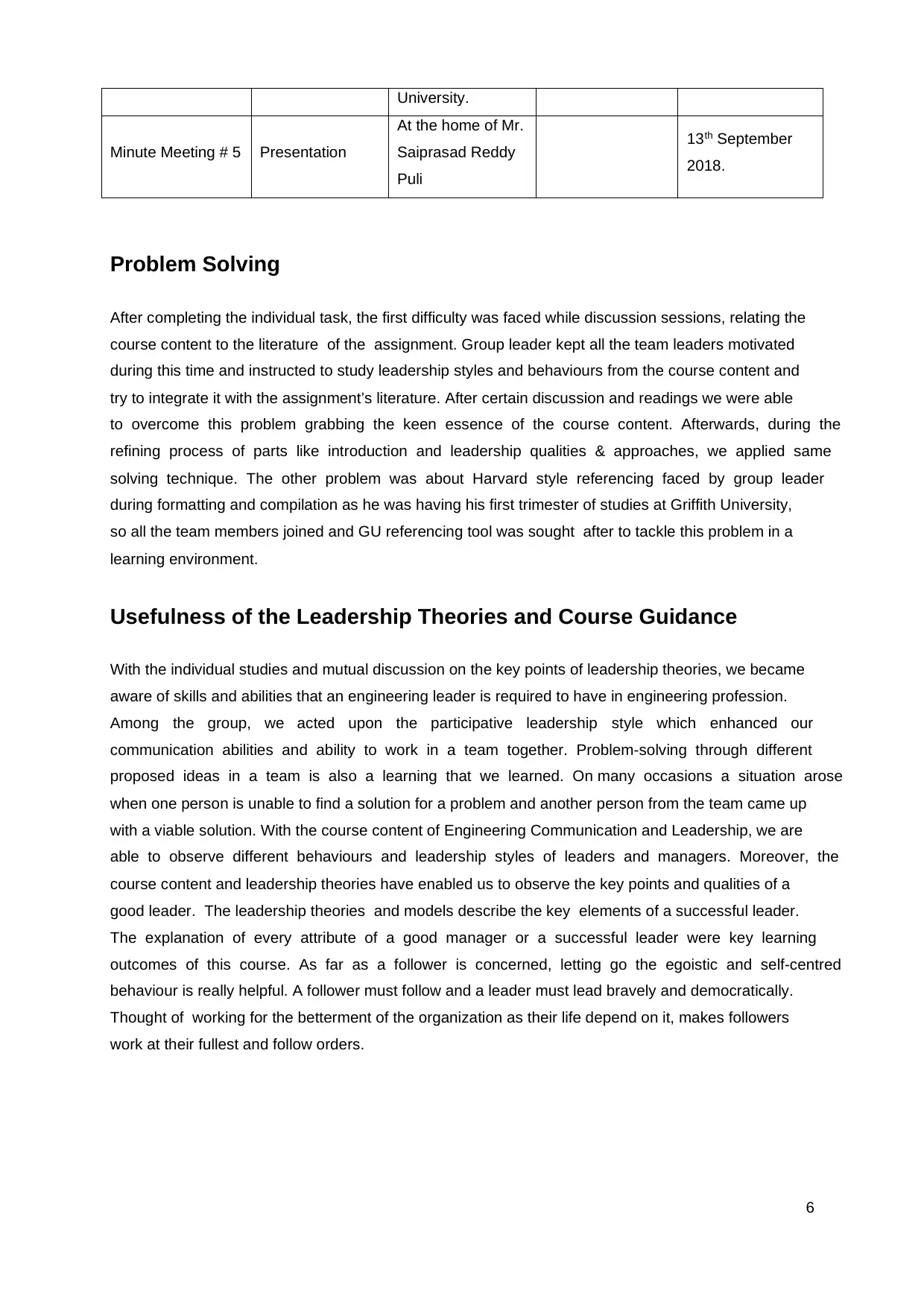
6
University.
Minute Meeting # 5 Presentation
At the home of Mr.
Saiprasad Reddy
Puli
13th September
2018.
Problem Solving
After completing the individual task, the first difficulty was faced while discussion sessions, relating the
course content to the literature of the assignment. Group leader kept all the team leaders motivated
during this time and instructed to study leadership styles and behaviours from the course content and
try to integrate it with the assignment’s literature. After certain discussion and readings we were able
to overcome this problem grabbing the keen essence of the course content. Afterwards, during the
refining process of parts like introduction and leadership qualities & approaches, we applied same
solving technique. The other problem was about Harvard style referencing faced by group leader
during formatting and compilation as he was having his first trimester of studies at Griffith University,
so all the team members joined and GU referencing tool was sought after to tackle this problem in a
learning environment.
Usefulness of the Leadership Theories and Course Guidance
With the individual studies and mutual discussion on the key points of leadership theories, we became
aware of skills and abilities that an engineering leader is required to have in engineering profession.
Among the group, we acted upon the participative leadership style which enhanced our
communication abilities and ability to work in a team together. Problem-solving through different
proposed ideas in a team is also a learning that we learned. On many occasions a situation arose
when one person is unable to find a solution for a problem and another person from the team came up
with a viable solution. With the course content of Engineering Communication and Leadership, we are
able to observe different behaviours and leadership styles of leaders and managers. Moreover, the
course content and leadership theories have enabled us to observe the key points and qualities of a
good leader. The leadership theories and models describe the key elements of a successful leader.
The explanation of every attribute of a good manager or a successful leader were key learning
outcomes of this course. As far as a follower is concerned, letting go the egoistic and self-centred
behaviour is really helpful. A follower must follow and a leader must lead bravely and democratically.
Thought of working for the betterment of the organization as their life depend on it, makes followers
work at their fullest and follow orders.
University.
Minute Meeting # 5 Presentation
At the home of Mr.
Saiprasad Reddy
Puli
13th September
2018.
Problem Solving
After completing the individual task, the first difficulty was faced while discussion sessions, relating the
course content to the literature of the assignment. Group leader kept all the team leaders motivated
during this time and instructed to study leadership styles and behaviours from the course content and
try to integrate it with the assignment’s literature. After certain discussion and readings we were able
to overcome this problem grabbing the keen essence of the course content. Afterwards, during the
refining process of parts like introduction and leadership qualities & approaches, we applied same
solving technique. The other problem was about Harvard style referencing faced by group leader
during formatting and compilation as he was having his first trimester of studies at Griffith University,
so all the team members joined and GU referencing tool was sought after to tackle this problem in a
learning environment.
Usefulness of the Leadership Theories and Course Guidance
With the individual studies and mutual discussion on the key points of leadership theories, we became
aware of skills and abilities that an engineering leader is required to have in engineering profession.
Among the group, we acted upon the participative leadership style which enhanced our
communication abilities and ability to work in a team together. Problem-solving through different
proposed ideas in a team is also a learning that we learned. On many occasions a situation arose
when one person is unable to find a solution for a problem and another person from the team came up
with a viable solution. With the course content of Engineering Communication and Leadership, we are
able to observe different behaviours and leadership styles of leaders and managers. Moreover, the
course content and leadership theories have enabled us to observe the key points and qualities of a
good leader. The leadership theories and models describe the key elements of a successful leader.
The explanation of every attribute of a good manager or a successful leader were key learning
outcomes of this course. As far as a follower is concerned, letting go the egoistic and self-centred
behaviour is really helpful. A follower must follow and a leader must lead bravely and democratically.
Thought of working for the betterment of the organization as their life depend on it, makes followers
work at their fullest and follow orders.
1 out of 11
Related Documents
Your All-in-One AI-Powered Toolkit for Academic Success.
+13062052269
info@desklib.com
Available 24*7 on WhatsApp / Email
![[object Object]](/_next/static/media/star-bottom.7253800d.svg)
Unlock your academic potential
Copyright © 2020–2025 A2Z Services. All Rights Reserved. Developed and managed by ZUCOL.





